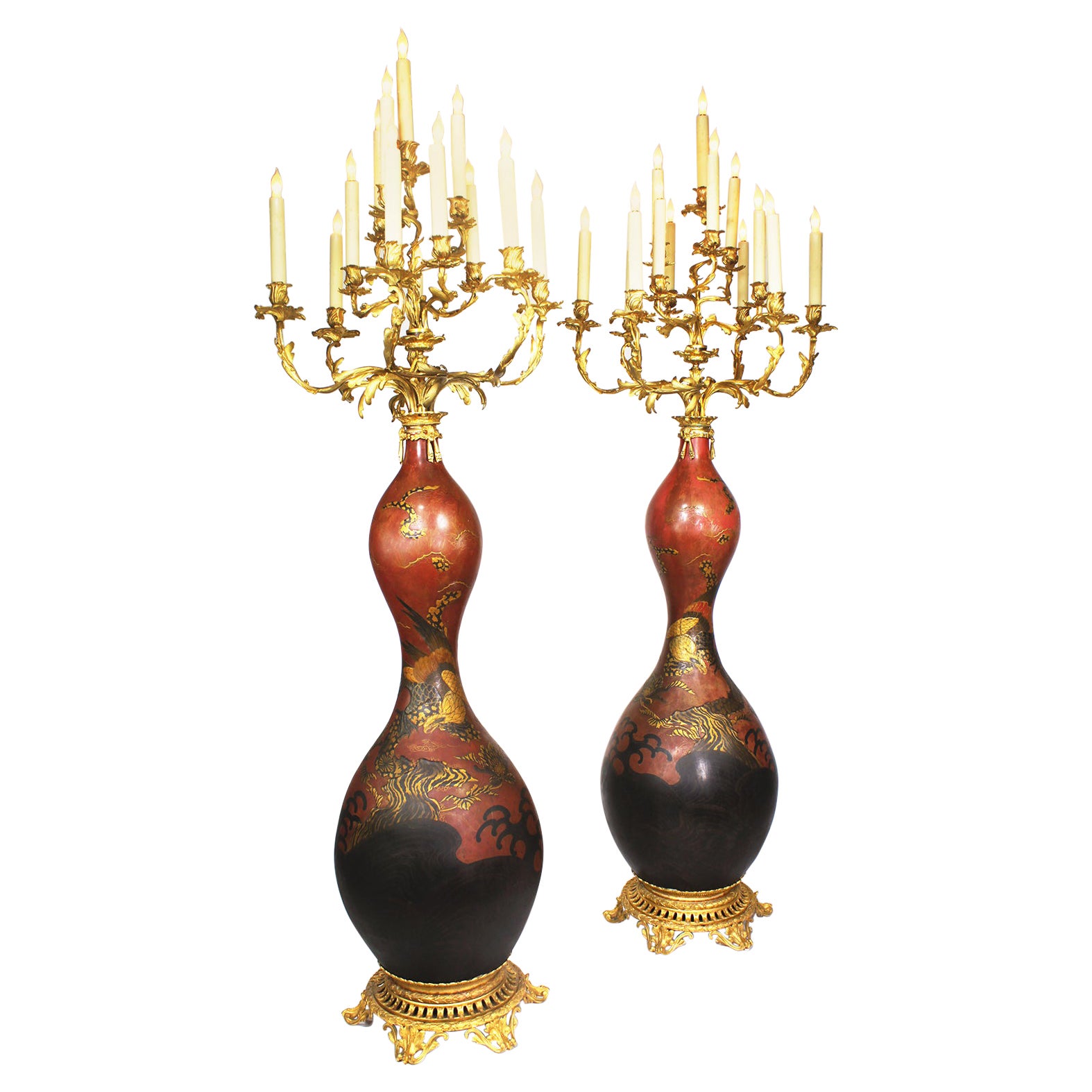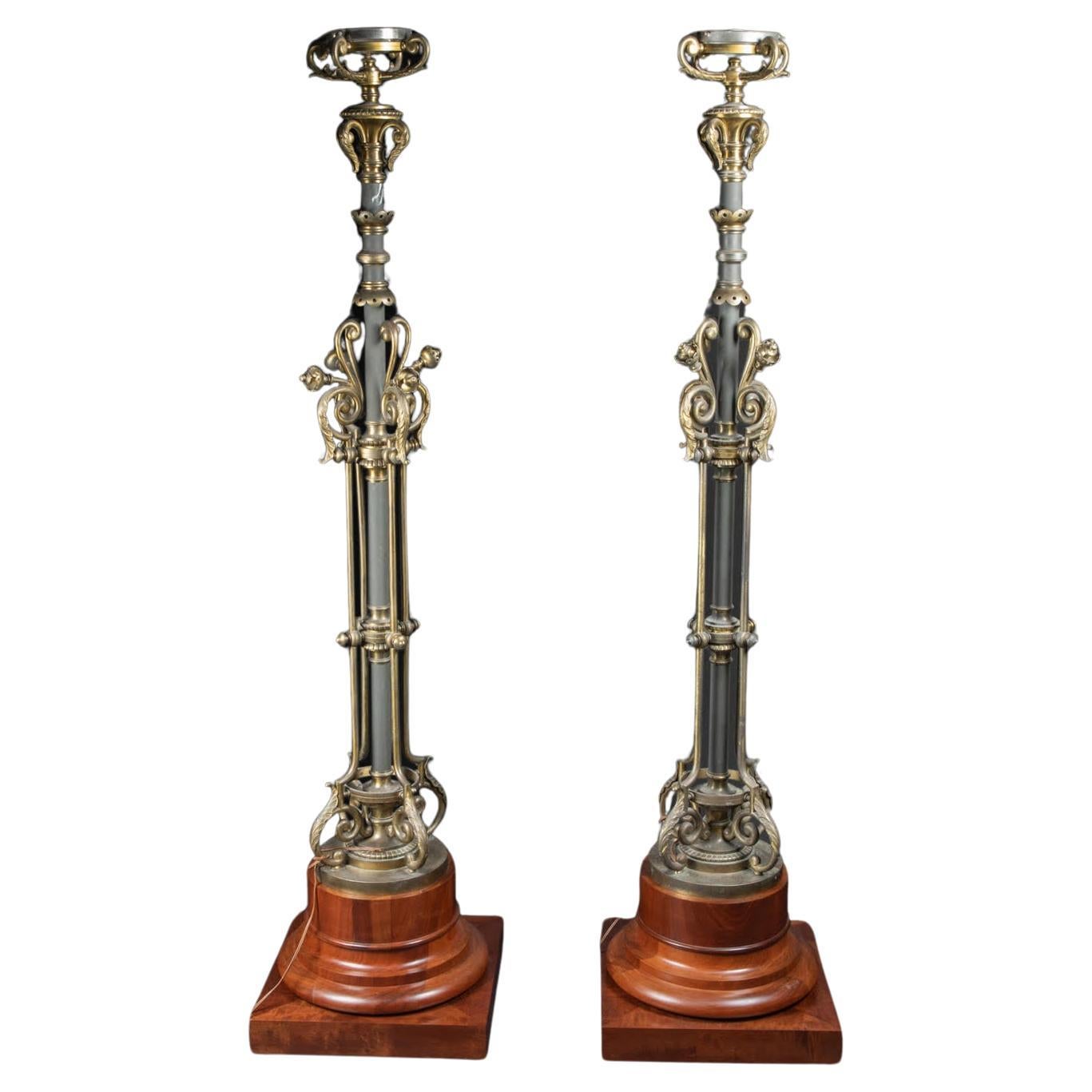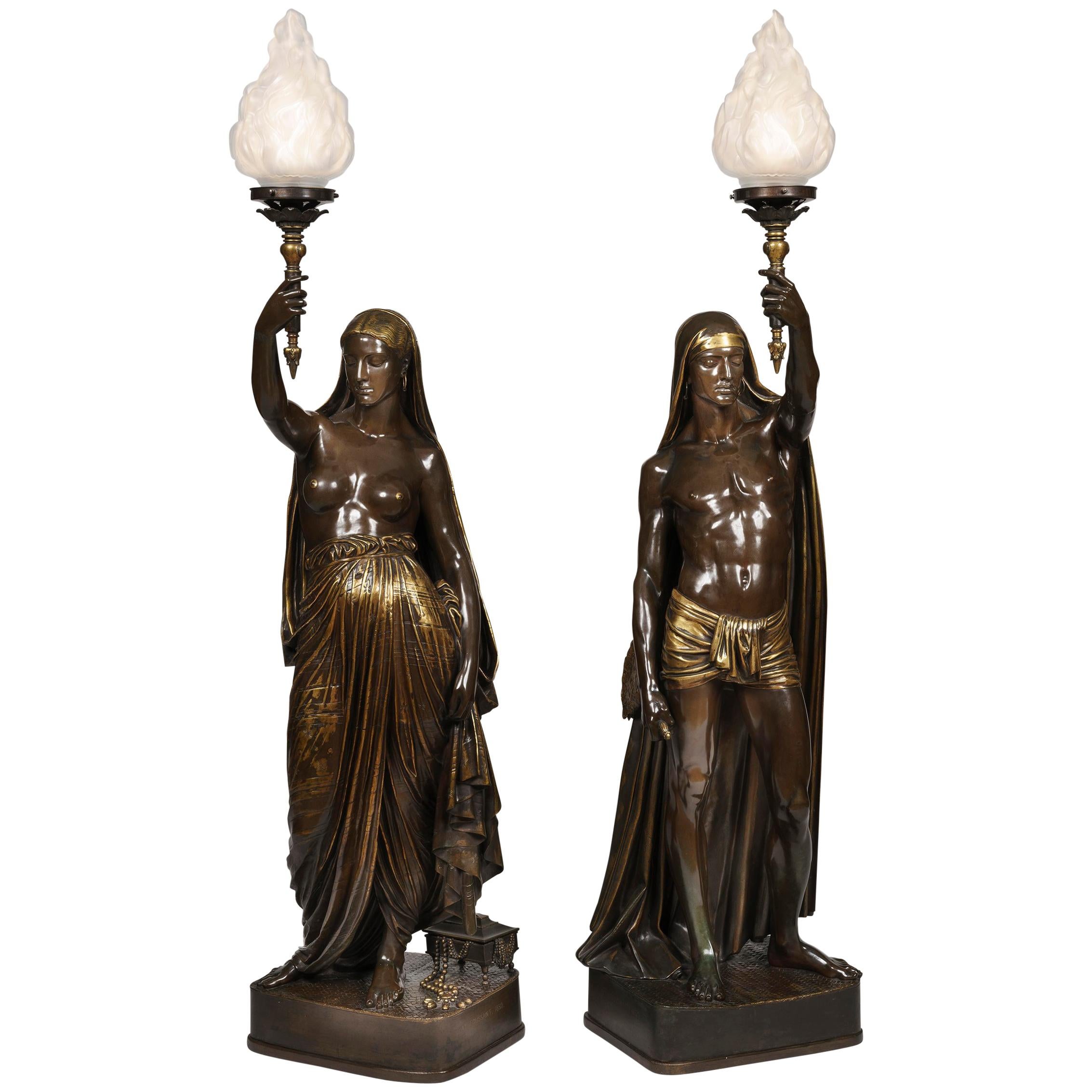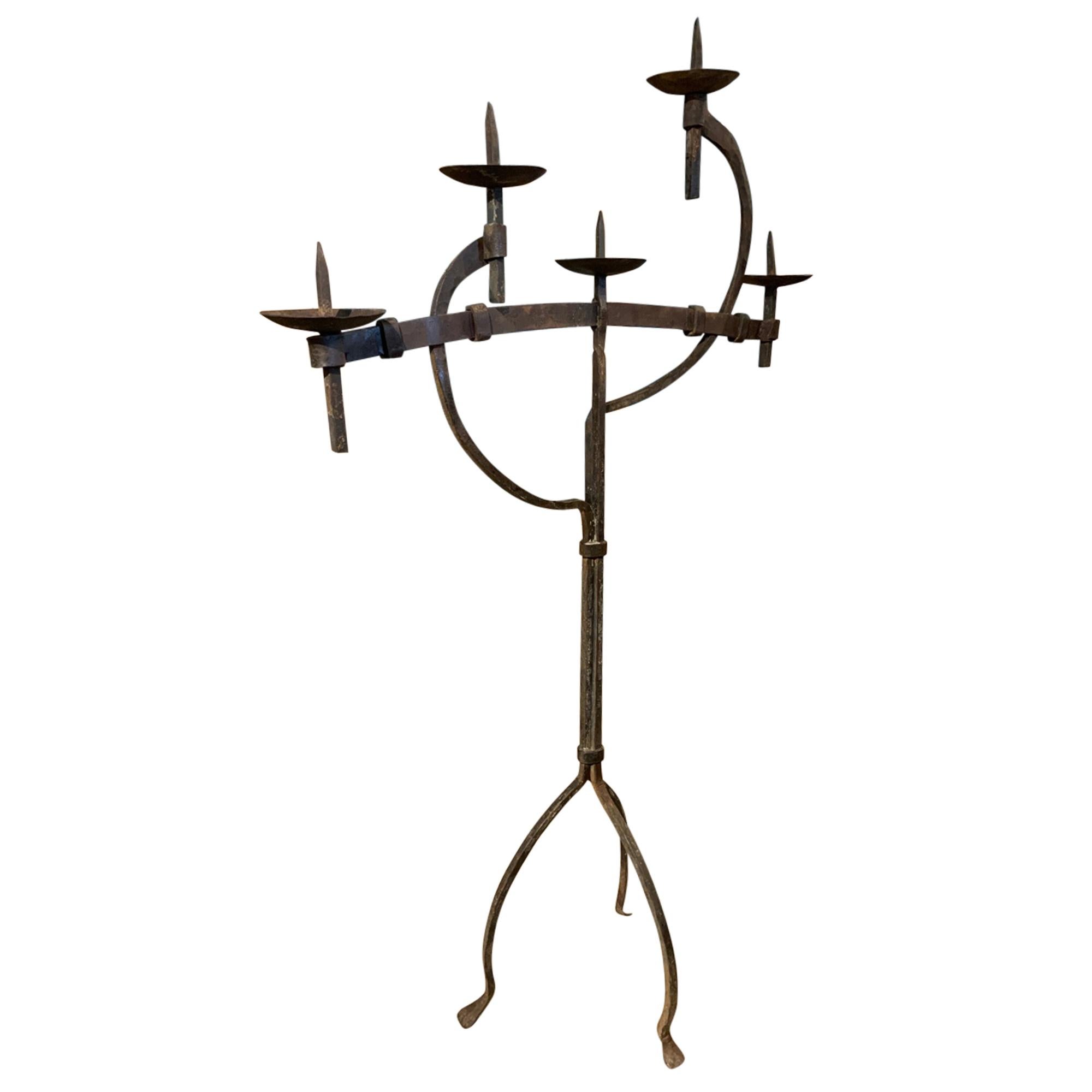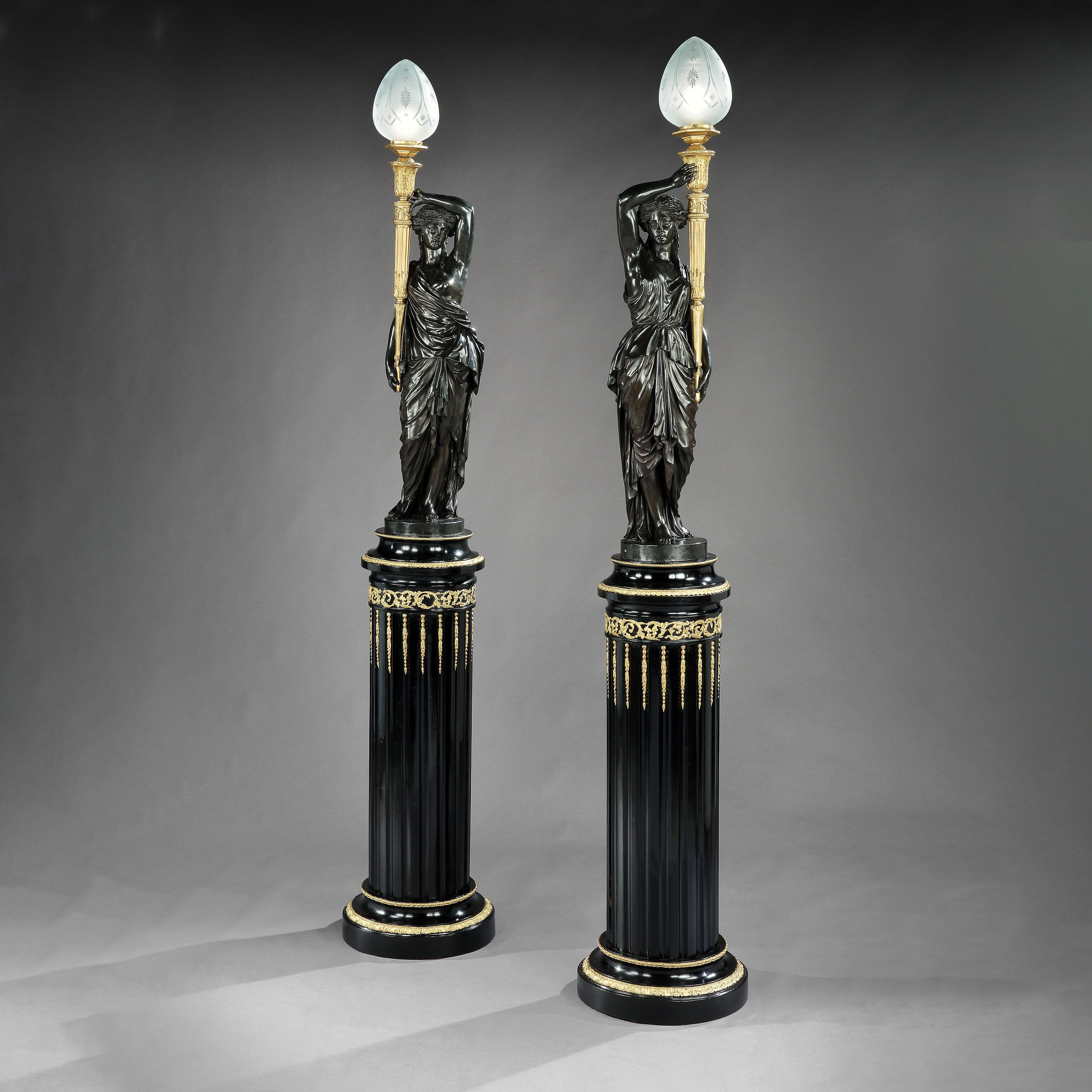Items Similar to Pair of 19th Century Carved Giltwood Torchères with Crystal Candelabra
Want more images or videos?
Request additional images or videos from the seller
1 of 8
Pair of 19th Century Carved Giltwood Torchères with Crystal Candelabra
About the Item
A Pair of Giltwood Carved Torchères
After the Design by Jean Pelletier
for the King's State Apartments
Supported on incurved tripartite plinths, the pair of torchères hand-carved in the French style, with three scrolled legs and a triangular tapering shaft adorned with descending husks, the circular gadrooned tops on a spreading acanthus leaf neck support. Together with their striking crystal and ormolu five-light girandoles.
English, circa 1890
Designed by Jean Pelletier (fl. c.1681-d.1705), a French émigré who worked for the English royal family, in the Louis XIV 'Roman' fashion popularised by Daniel Marot in the late 17th century.
The candle-stands can still be admired in Hampton Court Palace today, in King William III's State Apartments. Pelletier's important commission for the palace also included tables and mirrors, at the great cost of nearly £600, roughly equivalent to over two million dollars today.
- Dimensions:Height: 90 in (228.6 cm)Diameter: 20 in (50.8 cm)
- Sold As:Set of 2
- Power Source:Plug-in
- Style:Baroque Revival (Of the Period)
- Materials and Techniques:
- Place of Origin:
- Period:
- Date of Manufacture:circa 1890
- Condition:Repaired: Each item has undergone careful inspection and restoration by a conservation specialist in order to guarantee the original quality and integrity of the object. Wear consistent with age and use.
- Seller Location:London, GB
- Reference Number:
About the Seller
5.0
Recognized Seller
These prestigious sellers are industry leaders and represent the highest echelon for item quality and design.
Gold Seller
These expertly vetted sellers are highly rated and consistently exceed customer expectations.
Established in 1964
1stDibs seller since 2012
41 sales on 1stDibs
Typical response time: 3 hours
Associations
The British Antique Dealers' AssociationLAPADA - The Association of Arts & Antiques Dealers
- ShippingRetrieving quote...Ships From: London, United Kingdom
- Return PolicyA return for this item may be initiated within 3 days of delivery.
More From This SellerView All
- Large 19th Century Pair of Bronze Figural TorcheresBy Ferdinand Barbedienne, A. Toussaint - G. ChaudoirLocated in London, GBA pair of Figural Porte-Lumières, cast by Barbedienne from the celebrated Armand Toussaint Models Constructed in bronze, and having a patinated natural, and a highlighted gilt patin...Category
Antique Mid-19th Century French Romantic Floor Lamps
MaterialsBronze
- Magnificent Pair of 19th Century Bronze Figural Torchères by Henry DassonBy Henry DassonLocated in London, GBConstructed from patinated and gilded bronze, the large figures clothed in the Antique style, after the original design by Jean-Joseph Foucou, today residing at the Louvre, posed in ...Category
Antique 19th Century French Neoclassical Revival Floor Lamps
MaterialsBronze
- Pair of 19th Century French Patinated and Silvered Bronze Torchères Floor LampsLocated in London, GBImportant Pair of Antique Torchères in the Louis XV Manner Constructed in patinated and silvered bronze, and rouge brecciated marble; rising from serpentine marble bases, trimmed with silvered bronze tied cannelures, the tripartite scrolled legs issue columns incorporating addorsed syrinxes, holding reeded Pan pipes...Category
Antique 19th Century French Louis XV Floor Lamps
MaterialsMarble, Bronze
- Pair of French 19th Century Carved Giltwood 'Dolphin' PedestalsLocated in London, GBA Pair of Carved Giltwood 'Torchères Aux Dauphins' A rare and magnificent pair of torchères carved from solid wood, entirely gilded, rising from a tripartite base formed of addorsed and intertwined dolphins gathered around the central clustered column, with a further trio of mythical dolphins flanking carved shells to each side; the whole tapering towards the platform top. French, circa 1885 A variation of the famous 'torchères aux dauphins' first appearing in the 17th and 18th centuries, this pair shares the same recognizable structure. A pair can be seen at Belvoir Castle...Category
Antique 19th Century French Pedestals and Columns
MaterialsGiltwood
- Pair of 19th Century Carved Giltwood Mirrors in the Chippendale StyleBy Thomas ChippendaleLocated in London, GBA good pair of looking glasses In the manner of Thomas Chippendale The oval mercury glass plates housed within ornate rococo carved and pierce...Category
Antique 19th Century English Chippendale Wall Mirrors
MaterialsGiltwood
- 19th Century Pair of Louis XVI Style CandelabraLocated in London, GBA pair of Louis XVI style marble and gilt bronze candelabra. Rising from a square base supported by gilt bronze scrolling lions' paw feet, the red 'partridge eye' griotte marble s...Category
Antique Late 19th Century French Louis XVI Candelabras
MaterialsMarble, Griotte Marble, Ormolu, Bronze
You May Also Like
- Pair 19th Century Japanese Imari Porcelain & Gilt-Bronze Torchere CandelabraBy Imari PorcelainLocated in Los Angeles, CAA fine Pair of 19th century Japanese Imari Porcelain and French Gilt-Bronze Mounted Thirteen-Light Celadon Torchere Candelabra. The bottle-shaped Japonisme vases with a Royal red background, decorated with parcel-gilt and black soaring eagles in the hunt within a forestall scene. Each Vase fitted and surmounted with a French 19th century Louis XV Style 13-Light scrolled candelabrum and all raised on a circular pierced gilt-bronze plinth. circa: 1880. Imari Porcelain (????) is the name for Japanese porcelain wares made in the town of Arita, in the former Hizen Province, northwestern Kyushu. They were exported to Europe extensively from the port of Imari, Saga, between the second half of the 17th century and the first half of the 18th century. The Japanese as well as Europeans called them Imari. In Japanese, these porcelains are also known as Arita-yaki (???). Imari or Arita porcelain has been continously produced up through the present day. Characteristics Though there are many types of Imari, Westerners' conception of Imari in the popular sense is associated only with a type of Imari produced and exported in large quantity in mid-17th century. This type is called Kinrande. Kinrande Imari is colored porcelain with cobalt blue underglaze and red and gold overglaze. The color combination was not seen in China at that time. Traditional Ming dynasty color porcelain used dominantly red and green, probably due to scarcity of gold in China, whereas gold was abundant in Japan in those days. The subject matter of Imari is diverse, ranging from foliage and flowers to people, scenery and abstractions. Some Imari design structures such as kraak style were adopted from China, but most designs were uniquely Japanese owing to the rich Japanese tradition of paintings and costume design. The porcelain has a gritty texture on the bases, where it is not covered by glaze. There is also blue and white Imari. Kakiemon style Imari is another type of Imari, but it tends to be categorized separately in Europe. History "Imari" was simply the trans-shipment port for Arita wares. It was the kilns at Arita which formed the heart of the Japanese porcelain industry. Arita's kilns were set up in the 17th century, when kaolin was discovered in 1616 by the immigrant Korean potter, Yi Sam-pyeong (1579–1655). (He may also be known by the name, "Kanage Sambei".) Yi Sam-Pyeong, along with his extended family of 180 persons, left Korea on the offer of a privileged position in Japan. This decision was made after the occurrence of certain Japanese invasions of Korea. After Yi Sam-Pyeong's discovery, his kilns began to produce revised Korean-style blue and white porcelains, known as "Shoki-Imari". In the mid-17th century there were also a lot of Chinese refugees in Northern Kyushu due to the turmoil on Chinese continent, and it is said one of them brought coloring technique to Arita. Thus Shoki-Imari developed into Ko-KutaniImari. Ko-Kutani was produced around 1650 for both export and domestic market. Blue and white porcelain continued to be produced and they are called Ai-Kutani. Ko-Kutani Imari for the export market usually adopted Chinese design structure such as kraak style, whereas Ai-Kutani for the domestic market were highly unique in design and are accordingly valued very much among collectors. Ko-Kutani style evolved into Kakiemon style Imari, which was produced for about 50 years around 1700. Imari achieved its technical and aesthetic peak in Kakiemon style, and it dominated European market. Blue and white Kakiemon is called Ai-Kakiemon. Kakiemon style transformed into Kinrande in the 18th century. Kinrande used blue underglaze and red and gold overglaze, and later some other colors. Imari began to be exported to Europe because the Chinese kilns at Ching-te-Chen were damaged in the political chaos and the new Qing dynasty government stopped trade in 1656–1684. Exports to Europe were made through the Dutch East India Company, but the designation "Imari Porcelain" in Europe connotes Arita wares of mostly Kinrande Imari. Export of Imari to Europe stopped in mid-18th century when China began export to Europe again, since Imari was not able to compete against China due to high labor cost. By that time, however, both Imari and Kakiemon style were already so popular among Europeans, Chinese export porcelain copied both Imari and Kakiemon style, which is called Chinese Imari. At the same time, European kilns, such as Meisen also tried to copy Imari and Kakiemon. Export of Imari surged again in late 19th century (Meiji era) when Japonism flourished in Europe. Thus in western world today, two kinds of Imari can...Category
Antique 19th Century Japanese Japonisme Floor Lamps
MaterialsOrmolu, Bronze
- Pair of Torchères, Napoleon III Period, 19th Century.Located in Saint-Ouen, FRPair of torchères, Napoleon III period, 19th century. Pair of bronze torchères with mahogany base, Napoleon III period, 19th century. H: 188...Category
Antique 19th Century French Napoleon III Floor Lamps
MaterialsBronze
- French 19th Century TorchèreLocated in Atlanta, GAA very intriguing later 19th century French torchère - Standing candelabra - in expertly hand forged iron. A beautiful art piece.Category
Antique 19th Century French Floor Lamps
MaterialsIron
- Pair of Large Gothic Candelabra, 19th CenturyLocated in MARSEILLE, FRPair of large candelabras in the Gothic style, in painted bronze ("tree" part) and iron (base) The upper part is decorated with flowers and foliage, 7 lights with painted sheaths, a...Category
Antique 19th Century French Gothic Floor Lamps
MaterialsBronze, Iron
- Pair of French 19th-20th Century Neoclassical Style Cast Iron Figural TorchèresLocated in Los Angeles, CAA very fine pair of French 19th-20th century neoclassical style patinated cast iron figural torchères by A. Durenne, Paris, each representing a figure of a standing young maiden, her arms raised forward while holding a a flaming urn gas light (Now electrified) with a frosted glass flame, each raised on a veined grey marble column stand, both cast-signed 'A. Durenne, Paris'. Antoine Durenne was an internationally renowned French art founder. He attended École Nationale Supérieure des Beaux-Arts in 1842. Durenne purchased a small foundry in Sommevoire, near the Val d'Osne, Haute-Marne, France and established The Durenne firm, circa Paris, 1900. Cast-iron had been in production during the 18th century but its inferior status to the more fashionable and delicate wrought iron had generally confined its use to architectural work. By the early 19th century, however, rapid developments of the Industrial Revolution combined with the simultaneous burgeoning of a new middle class provided the impetus for a dramatic Expansion in its application and in a short space of time a proliferation of iron foundries across Europe and America thrived on the production of everything from inkstands to railway stations. The use of cast-iron for garden ornament became particularly widespread at this time, as the possibilities for its mass-production at a fraction of the cost of bronze made it the material of choice for outdoor statuary...Category
Antique Early 1900s French Neoclassical Revival Figurative Sculptures
MaterialsMarble, Iron
- Pair of 19th Century Venetian Tole Floor LanternsLocated in Palm Beach Gardens, FLA beautiful pair of 19th Century Italian Venetian tole lanterns. Hand-forged of wrought iron, the lanterns are embellished with acanthus leaves and flower blooms, supported by a twis...Category
Antique Mid-19th Century Italian Baroque Revival Lanterns
MaterialsWrought Iron
Recently Viewed
View AllMore Ways To Browse
English Floor Candelabra
Crystal Torchere
Crystal Floor Candelabra
Antique Ormolu Crystal Table Lamp
Nelson Cigar Lamp
Bliss Tulip Lamp
Holtkoetter Leuchten
Laurel Magazine Floor Lamp
Modernist Hollywood Regency Murano Pink Glass Flower Lamp
Faina Floor Lamps
Christopher Tennant
Livio Gae
Gae Aulenti Livio Castiglioni
Magneto Lamp
Nestore Lamp
Carlo Giorgi For Bottega Gadda Floor Lamp
Wiener Werkstatte Floor Lamp
Ettore Fantasia Gino Poli Sothis
